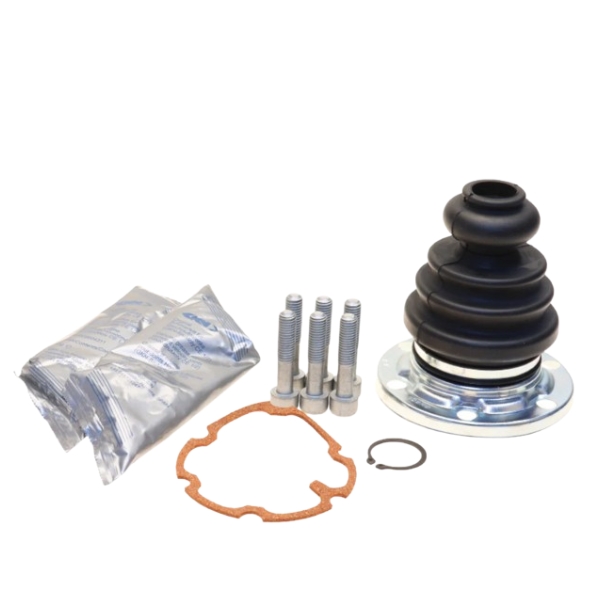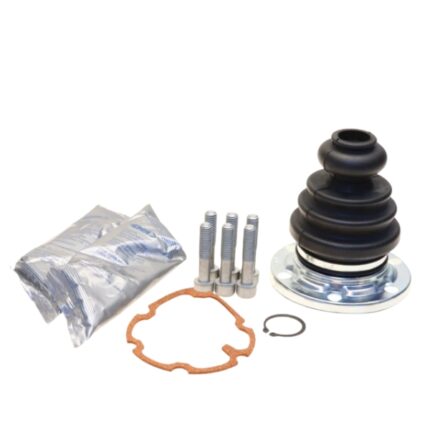Get Audi 200 20v T Inner CV Joint Boot Kit 443498201B in Kenya
A CV (Constant Velocity) joint boot kit is a crucial component in vehicle maintenance, particularly in ensuring the longevity and proper functioning of the CV joints in a car. To understand the importance and details of a CV joint boot kit, it’s essential to delve into the anatomy of a CV joint, the purpose of the boot, common issues, the contents of a typical boot kit, and the process of replacement.
Anatomy and Function of a CV Joint
The CV joint is an integral part of a vehicle’s drivetrain, allowing power to be transmitted from the transmission to the wheels at a constant speed while accommodating the up-and-down motion of the suspension. This is particularly important in front-wheel-drive vehicles, although rear-wheel-drive and all-wheel-drive vehicles also have CV joints. There are two main types of CV joints: the Rzeppa joint, which is more common in front axles, and the tripod joint, typically found on the inner side of the drive axle.
The CV joint must be flexible to accommodate various angles while ensuring smooth power delivery. Without it, the vehicle would not be able to handle the different angles required for turning or dealing with road bumps. However, because the CV joint is so critical, it must be protected from dirt, moisture, and other contaminants, which brings us to the role of the CV joint boot.
The Role of the CV Joint Boot
The CV joint boot is a flexible, rubber or thermoplastic cover that encases the CV joint. It serves two primary purposes:
- Protection: The boot shields the CV joint from dirt, debris, and moisture. Any contamination inside the CV joint can cause significant wear and tear, leading to the joint’s premature failure.
- Lubrication Containment: The boot also contains the special grease that lubricates the CV joint. This lubrication is essential for the smooth operation of the joint, reducing friction and wear. If the grease leaks out due to a damaged boot, the CV joint will wear out much more quickly.
Common Issues with CV Joint Boots
Over time, CV joint boots can deteriorate due to exposure to the elements, especially extreme temperatures, road salt, and chemicals. The most common issues with CV joint boots include:
- Cracks or Splits: Rubber and thermoplastic materials can crack or split over time, especially in harsh conditions. A cracked boot can allow contaminants to enter and grease to escape.
- Tears: A tear in the boot, often caused by road debris or excessive stretching, can quickly lead to a loss of lubrication and contamination of the joint.
- Loose Clamps: The clamps that secure the boot to the joint and axle can sometimes loosen, leading to grease leakage and boot movement.
When these issues occur, they can lead to CV joint failure if not addressed promptly. That’s where a CV joint boot kit comes into play.
Contents of a CV Joint Boot Kit
A typical CV joint boot kit includes the following components:
- CV Joint Boot: The primary component, usually made from rubber or thermoplastic, which fits over the CV joint to protect it.
- Grease: High-quality grease is provided to lubricate the CV joint. The grease typically included in the kit is specially formulated for high temperatures and friction conditions.
- Clamps: Metal clamps are used to secure the boot in place on both the axle and the CV joint. These are usually made of stainless steel or another corrosion-resistant material.
- Other Accessories: Depending on the vehicle and the kit, additional items like washers, O-rings, or spacers might be included to ensure a proper fit.
The Importance of Using a CV Joint Boot Kit
Using a CV joint boot kit is essential for maintaining the health of your vehicle’s drivetrain. Here are a few reasons why:
- Cost-Effective Maintenance: Replacing a CV joint can be expensive. A boot kit, however, is relatively inexpensive and can prevent the need for a full CV joint replacement.
- Prolonging CV Joint Life: By replacing a damaged boot, you can extend the life of the CV joint significantly. Proper lubrication and protection from contaminants are vital for the longevity of the joint.
- Preventing Further Damage: A damaged boot can lead to further problems in the drivetrain if not addressed. Contaminants can spread to other components, and loss of lubrication can lead to significant wear.
Benefits of a CV Joint Boot Kit
1. Protection from Contaminants
The CV joint boot serves as a protective barrier that prevents dirt, debris, water, and other contaminants from entering the CV joint. These contaminants can cause significant damage by grinding against the joint’s surfaces, leading to accelerated wear and potential joint failure.
2. Lubrication Containment
One of the essential functions of the CV joint boot is to keep the lubricating grease inside the joint. Proper lubrication reduces friction, prevents metal-to-metal contact, and minimizes wear. A well-maintained boot ensures that the CV joint remains properly lubricated, which is crucial for smooth operation and longevity.
3. Cost Savings
Replacing a damaged CV joint boot is far less expensive than replacing the entire CV joint. A CV joint boot kit is a cost-effective solution that can prevent more extensive and costly repairs down the line. By addressing a damaged boot early, you can avoid the need for a complete CV joint replacement.
4. Prolongs CV Joint Life
By protecting the CV joint from contaminants and maintaining proper lubrication, a CV joint boot kit significantly extends the life of the CV joint. This prolongs the overall life of the drivetrain, ensuring that your vehicle runs smoothly for longer.
5. Prevents Further Damage
If a CV joint boot is damaged and not replaced, it can lead to grease leakage and the introduction of contaminants into the joint. This can cause the CV joint to wear out quickly, leading to further damage to other drivetrain components. A CV joint boot kit prevents this cascading damage by maintaining the integrity of the joint.
6. Improves Vehicle Performance
A properly functioning CV joint is crucial for the smooth transmission of power from the engine to the wheels. By ensuring that the CV joint is protected and lubricated, a CV joint boot kit helps maintain optimal vehicle performance, especially during turns and over uneven surfaces.
7. Enhanced Safety
A damaged CV joint can lead to unpredictable vehicle behavior, particularly when turning or accelerating. Replacing a damaged boot with a new one from a CV joint boot kit helps maintain the reliability and safety of the vehicle, reducing the risk of accidents due to drivetrain failure.
8. Ease of Installation
Most CV joint boot kits are designed for ease of installation, making it possible for individuals with moderate mechanical skills to replace a damaged boot themselves. This can save time and money compared to taking the vehicle to a mechanic.
9. Compatibility and Customization
CV joint boot kits are typically designed to fit specific vehicle models, ensuring a perfect fit. This compatibility ensures that the boot will perform its protective functions effectively, without the need for modifications. Additionally, some kits offer high-quality materials, such as thermoplastic or silicone, that may provide enhanced durability compared to standard rubber boots.
10. Environmental Protection
By prolonging the life of the CV joint and preventing the need for frequent replacements, using a CV joint boot kit contributes to environmental protection. Fewer parts need to be manufactured and disposed of, reducing the overall environmental footprint associated with vehicle maintenance.
Signs of a worn out CV Joint Boot Kit
1. Visible Tears or Cracks in the Boot
The most direct sign of a worn-out CV joint boot is physical damage, such as cracks, splits, or tears in the rubber or thermoplastic material of the boot. This damage is often visible upon inspection of the axle area. If the boot is torn, it will no longer protect the CV joint from contaminants or keep the grease contained, leading to further issues.
2. Grease Leaks Around the Wheel
A damaged CV joint boot often leads to grease leaking out of the joint. This grease is typically thick and sticky, and it may appear around the inside of the wheel, on the suspension components, or splattered along the undercarriage. The presence of grease in these areas is a clear indicator that the boot is compromised.
3. Clicking or Popping Sounds While Turning
One of the most common symptoms of a CV joint issue, often caused by a damaged boot, is a clicking or popping noise when turning the vehicle. This sound occurs because the CV joint has lost lubrication or has become contaminated, causing metal components to grind against each other. The noise is usually more pronounced during sharp turns or when accelerating.
4. Vibration While Driving
A worn-out CV joint boot can lead to an imbalance in the CV joint, which in turn can cause vibrations while driving. These vibrations are often felt in the steering wheel or the floor of the vehicle, particularly when accelerating or driving at high speeds. If you notice unusual vibrations, it’s important to inspect the CV joint and boot.
5. Excessive Play in the CV Joint
If you physically inspect the CV joint and notice excessive play or movement, this could indicate that the joint is wearing out, possibly due to a damaged or missing boot. Normally, the CV joint should have minimal play; significant movement suggests that the joint has been compromised.
6. Strange Noises When Accelerating
In addition to clicking sounds during turns, a damaged CV joint may also produce a knocking or clunking noise when accelerating. This is particularly noticeable when accelerating from a stop or when quickly applying the throttle. The noise is a sign that the CV joint is struggling to function correctly due to lack of lubrication or contamination.
7. Reduced Steering Response
A damaged CV joint, resulting from a worn-out boot, can affect the steering response of the vehicle. You might notice that the steering feels less precise or more difficult, particularly during turns. This can be a dangerous sign and should be addressed immediately.
8. Grease on the Ground Under the Vehicle
If the CV joint boot has been torn for some time, you might find spots of grease on the ground where your vehicle has been parked. This grease can drip from the joint and leave noticeable marks on the pavement or garage floor.
9. MOT or Inspection Failures
During routine vehicle inspections or MOT tests, a worn-out CV joint boot may be flagged by a mechanic. This is because a damaged boot is a safety concern and could lead to more severe problems if not replaced. Regular inspections can help catch this issue before it leads to more expensive repairs.
10. Uneven Tire Wear
While less common, uneven tire wear can sometimes be associated with a CV joint issue, particularly if the joint has been compromised for an extended period. This is because a failing CV joint can lead to improper alignment or suspension issues, which in turn affects how the tires wear.
Follow us on Facebook for more parts.




